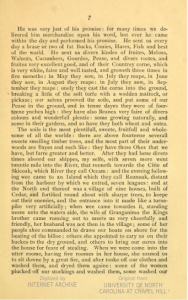
7th page from Arthur Barlowe’s account of his expedition, digitized by the University of North Carolina at Chapel Hill.
This source is an account of one of the first expeditions to the United States. It is written by Arthur Barlowe, one of the captains. This account is addressed to Sir Walter Raleigh. It is a long piece that describes what they found when they first made landfall and interactions with Native Indians in the area, however a couple paragraphs in particular also discuss the food and agriculture. When the voyagers arrived, they were hosted and taken care of. Barlowe writes about the many types of food they were given: fish, bucks, melons, walnuts, gourdes, pease, and corne for example. He then discusses the planting schedule and how they plant the corn and peas. Barlowe then describes the soil as “plentifull, sweete, fruitfull, and wholesome.” [1]
This piece is significant because it is one of few written accounts of the early voyagers to the East Coast. It describes what foods were grown or hunted in the area during the 1500s in the area. This is the type of foods that early colonizers and members of the colonies were eating and growing. This is important for understanding present-day North Carolina because while food practices have changed throughout the years, the quality of our soil and crops that can be grown here has probably stayed similar. There is still a lot of peas, beans, and corn grown in the state, and fish and deer meat is also commonly hunted here. It is important to note that while food practices on the coast differ to those more inland, there are many similarities.
While the title of this written account claims that the voyagers were in “Roanoke,” it is more likely that they were in Roanoke Island, not the inland city of Roanoke, Virginia. Roanoke Island is in present-day North Carolina, along the Outer Banks, They also called where they were Virginia because North Carolina did not become a colony until 1663.[2]Because of this, it is reasonable to apply this account of early North Carolina to the present-day Chapel Hill area.
[1]. Ashe, Samuel, History of North Carolina. (Greensboro, NC: Charles L. Van Noppen, 1908), 68.
[2]. Barlowe, Arthur,The First Voyage to Roanoke, 1584: The First Voyage Made to the Coasts of America, with Two Barks, wherein Were Captains M. Philip Amadas and M. Arthur Barlowe, Who Discovered Part of the Countrey Now Called Virginia, anno 1584. Written by One of the Said Captaines, and Sent to Sir Walter Raleigh, Knight, at Whose Charge and Direction, the Said Voyage Was Set Forth. (Boston, MA: Directors of the Old South Work, 1898), 7.
By: Emma Kroll-Smith